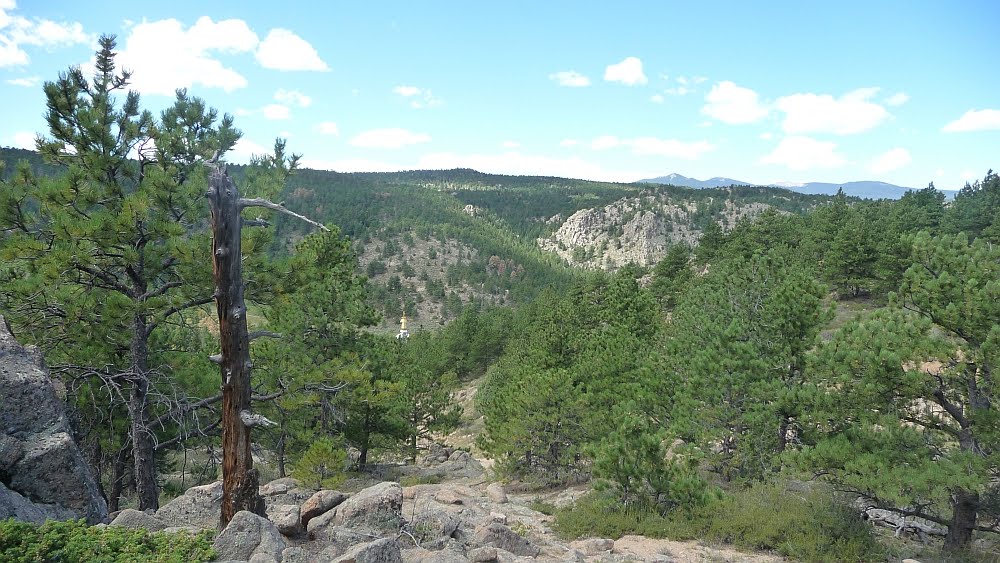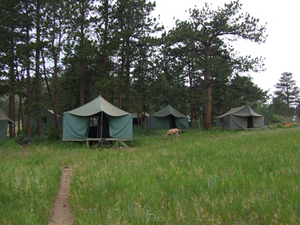Monday
Community ArticlesHelp Save Trees at SMC
Bob and Lindy King share their concern for the survival of the Ponderosa Pine forest at Shambhala Mountain Center in this poignant and timely call for action. They ask the Shambhala community to take to heart this very serious and imminent threat to the trees at Shambhala Mountain Center and see if you are inspired to help.
The grim scenario is that virtually every tree at SMC will die.
The mountain pine beetle is no bigger than a piece of pencil lead and yet this little insect and the fungus it carries will most assuredly kill virtually every Ponderosa Pine tree on the land over the next 5 years. Other than the clumps of aspen trees, Shambhala Mountain Center’s mature trees are 90% Ponderosa. You may well have seen the vast tracks of dead forest left in the wake of the beetles march across the western slopes of Colorado. They have now crossed the continental divide and arrived at SMC, killing 2,400 trees last year alone.
It is possible to save some trees.
Right now we have the option of saving trees by preventative spraying. We have located an experienced company that we like and trust, called Timberline, who will spray for us using the most benign and ecological insecticide that is still effective. The product is called Permethrin, which is a synthetic version of an insecticide made from the extract of, most auspiciously, the chrysanthemum flower.
Although using any kind of insecticide is undesirable, this one is relatively non-toxic, being used in insect repellent creams, indoor bug bombs, human lice treatments and around food crops.
Timing is crucial. We must spray within a month.
The beetles fly from their host trees which are now dead, as early as mid June. There is nothing to be done after the beetles enter a tree, so the spraying must occur late May or early June. Although we are on Timberline’s schedule, we have not yet determined how many trees we can afford to spray. This will depend in large part on your response.
Cost: Not much more than removing dead trees.
The cost of spraying each tree is $9.25 per year for an estimated 5-6 years (the actual duration of the beetle epidemic depends on numerous unpredictable factors), so it is roughly $50 per tree. It costs an average of $34 per tree to remove dead ones, which we would need to do for fire prevention, further beetle control and aesthetic reasons. The difference is only $16 per tree! And at that point, we have not only saved a tree but also saved the land from being torn up by the tree removal machinery.
The benefits: visual, financial and environmental.
Obviously the difference between an SMC with trees and the unbearable image of SMC without trees is immeasurable. Beyond the visual and emotional horror, there would most certainly be a substantial economic impact in terms of SMC’s desirability as a program venue. (Just imagine, for example, all of the campgrounds and tents having no shade trees.) Beyond just aesthetics, the ecological benefit of saving a tree is enormous: wildlife habitat, windbreak, soil erosion control, shade, oxygen production, global warming , etc. The effect of saving one mature pine tree is roughly equivalent to not driving 750 miles each year, in terms of carbon footprint.
If you feel inspired to help.
You can save one tree by donating $50 or save 20 trees by donating $1000 or, of course, any other quantity that you choose. You also have the option of donating your desired amount now and pledging to donate that same amount for the next 4 years, multiplying your impact over time.
If you get to Shambhala Mountain Center in the next year you can pick out the individual tree or trees that you have saved and mark them with a special ribbon which will be provided for you. Remember that any given tree that is sprayed has a 94% chance of surviving the beetle epidemic.
Please contribute to our efforts…
Or send a check made out to Shambhala Mountain Center marked “Save a Tree” to:
Shambhala Mountain Center
151 Shambhala Way
Red Feather Lakes, CO 80545
Please know that we, Lindy and Bob, will be working closely with SMC over the next 5 years to help manage this project and the funds associated with it. We will keep you posted on the progress we make and any new developments with annual e-mails.
Thank you so much for joining us in this endeavor to save trees at Shambhala Mountain Center. In doing so, we know we are avoiding painful remorse that we would definitely feel if we were to miss this critical opportunity for action.
Genuinely yours,
Bob and Lindy King







Sep 27, 2011
Reply
We have been working on a project for saving Earths’ mountain forests.
We hope it can help you
We’d love to hear from you
http://www.activeremedy.org.uk
Truly
Stella Joy
May 12, 2011
Reply
Kelly, just go to SMC and see the damage with your own eyes. It’s not theoretical but plainly visible.
Pine beetles historically have been kept in check by cold spells. Because pine beetles produce an antifreeze when they hibernate it takes -43 degrees in winter to kill them… or if one gets lucky, a few very cold days when they are not hibernating.
May 12, 2011
Reply
To kelly –
I worked for Shambhala Mountain Center surveying these trees in 2010, and can attest to the statement that “The grim scenario is that virtually every tree at SMC will die.” It is no ‘media scare’ – I’ve personally seen and counted the thousands of trees that are dead and dying. As it also states in the article, the spraying must be done within the month to prevent another season of beetles and thousands more dead pines on SMC land. I am sure that all those involved have done their research and determined this to be the best course of action with all environmental concerns taken into account.
And although you say “No one wants to lose all the trees at SMC, but that scenario is highly unlikely,” I would suggest that you take a drive across Colorado’s western slopes and “see[n] the vast tracks of dead forest left in the wake of the beetles march.”
May 12, 2011
Reply
I haven’t researched the Pine Beetle / tree death scenario, but I am for one am suspicious. Having researched a number of topics deeply, I don’t readily go along with mainstream scares. I am exceedingly skeptical of statements like ‘The Pine Beetle problem has been linked to global warming.’ Global warming is poorly established science (anyone looking for that debate is welcome – I have moved from believer with vague info to educated skeptic).
IMO, the worst environmental catastrophes of late are typically man-made. If we let nature alone, she would correct herself. No one wants to lose all the trees at SMC, but that scenario is highly unlikely. No one wants to lose all the trees anywhere at a place they love. But if we all spray poisons on millions of acres (because we wont’ be the only ones doing it), then the total damage will be pretty high. Don’t we have enough chemicals, heavy metals, and radiation already? I’m against the spraying – I half-suspect it’s little more than a media scare planted by the logging industry (may as well cut ’em down – we had to destroy the village to save it.)
We want to be trusting and think we’re doing the right thing. We want to take care of things, but the truth is, we usually make it worse. And by killing billions of these creatures, will we make it better? Is mass poisoning the answer?
Lastly, I hope that we can keep this civil. I deeply appreciate Bob and Lindy’s concern for our precious SMC, but I cannot agree that the spraying of more chemicals, in the wake of Fukishima and BP, is the best answer. We need to let the cycle of creation and destruction get itself back into balance and quit trying to control it. It is not helping on a global scale. Can it really work on a smaller one?
May 12, 2011
Reply
There is some kind of scent the bettles release to tell others that the tree is full. Spraying that prevent further infestation.
http://www.botanicalgarden.ubc.ca/forums/showthread.php?t=9045
http://www.barkbeetles.org/mountain/fidl2.htm
May the stately ponderosa around SMC and beyond thrive and flourish.
Peace
May 9, 2011
Reply
The upside of permethrin is a 94% chance pine beetles that attack a tree do not live to kill it. In Colorado the pine beetle season is short enough that only a single treatment of permethrin is required per year.
The downside of permethrin is that it kills aquatic life (don’t spray near any stream or lake) and that it kills many other beneficial insects such as bees and ants. The trees can also end up covered in a type of cobweb made by a pin-head sized spider colony (sorry I’ve forgotten their name). This happens because the predator of that spider is killed by permethrin.
It’s a hard problem since if all the trees die in Colorado there are large scale effects not only on the wildlife (no food for squirrels) but also on the snow cycle (flooding followed by droughts). On the other hand, one has to be careful not to overspray since permethrin can get into the water ( http://www.summitdaily.com/article/20081102/NEWS/811029958/1002/NONE&parentprofile=1055&title=Chemicals%20found%20in%20Grand%20County%20lake ).
The alternative repellents unfortunately either don’t work very well (verbenone) or are highly toxic (carbaryl) so permethrin seems to be the best alternative. SMC’s getting a good deal on the spraying — it usually costs around $14 per tree per year near Boulder.
Pine beetles prefer to eat the type of tree they were born in. However if there’s not enough food they will eat whatever’s around. Therefore one can’t assume they’ll only eat lodgepole pines for instance.